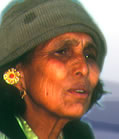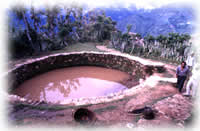 |
 |
||
 |
|||
|
RELATED THEMES agriculture community activities development employment and income environment spiritual beliefs OTHER LOCAL THEMES BACKGROUND |
water
Several narrators highlight how some modern developments are affecting people's willingness to work communally on the maintenance and conservation of water resources: "with water available from the taps these days, people couldn't care less about the ponds. [But] they were built by our ancestors for use during emergencies, we said. But no one listened to us. Who listens to the aged? .... People who went to clean the pond divided the area, saying so much pond sediment for me, so much for you.... [But] now, with the introduction of chemical fertilisers, nobody cares for the rich sediment from the ponds" (Nepal 19). This narrator is in his 90s and feels that young people not only fail to recognise the practical value of the ponds, they disregard the spiritual element in their construction and maintenance. "Because [building a pond] was considered a pious act, all the people in the village helped dig and carry the soil" (Nepal 19). Others tell a more positive tale of communities still working together, if at a reduced level, to improve their lives with the careful husbanding of water resources, and linking such activities with other forms of development. When one community was threatened by severe landslides, it sought advice from a watershed development project. Constructing a pond controlled the floodwaters, as well as providing crop irrigation and water for livestock. "In the past, there were old ponds here. We thought then that they were made solely as watering holes for cattle since the water source was far away. When water came to every house, these ponds lost their value. However, having seen the worth of the present pond, I realise those ponds of the past were also made to control floods" (Nepal 22). Being able to irrigate in winter allows for a second crop of paddy. In addition, say several narrators, irrigation has transformed vegetable growing. A man whose community canal was destroyed is concerned about the effect on those who depended on it. "We had a community irrigation canal. [we] tenant farmers made it. there was enough water for our seven households to cultivate winter crops. [Then] the Melamchi Drinking Water Project was conceived to take water to Kathmandu. To make a road for that project, they covered our canal. They told us then that even if the canal were destroyed, we could still bring in water through concrete pipes. I have no faith in their words, now. The old canal has disappeared, and we have no alternative. I am worried that all the paddy fields will lie barren." He describes in detail how they used to construct such canals: "There were no drawings and no overseers... no measurements then, no pegs were placed and no ropes used.... Believe me, water would reach exactly where we intended" (Nepal 20). quotes about water"After the rain people used to grow vegetables in the sheltered cold or moist lands; otherwise their gardens were barren. But now with the irrigation canal, people are planting whatever they like in their gardens. Some even grow mustard and extract oil themselves, and sell it in the market too." "Running the [water] mill involves a lot of hard work. The wooden trough has to be cut, wooden pegs have to be made, the central pivot has to be placed to support the rotating grinder, ploughshares and levers have to be obtained, and the ground has to be levelled. And, of course, we have to have a pair of stone grinders. Water has to be channelled to the grinder through the wooden trough.... We can then feed the corn into the grinder.... We have to constantly monitor the quality of the final product. Is it coarse and rough, or smooth and fine? The force of the water has to be monitored. In case the force is not strong, water flow has to be increased. This may require diverting more water from the river to the mill..." "As far as I can remember there were many water mills here; up there, up there, on the other side there, this side near the stream, behind the village. But most have been abandoned. In our case, we just can't afford to leave." "We clean these wells on a particular festive day every year. Everyone from the village joins hands to clean the wells.... We also perform religious ceremonies at the well." "It's been about 6-7 years since we started having two harvests. There was no practice of planting vegetables before. There was no water, how could we plant? How could anything grow without water? .We ourselves brought it.We built a canal from the river. We started investing our own money and.we now have irrigation both in winter and summer." "We must complete the digging of a [new] well within three to four days.... Otherwise, it sinks and caves in....The upper level of the well, from where surface water is likely to get into the well, is smeared with a kind of soil that is not destroyed by fire or water. Moon-shaped stones are laid at the bottom of the well leaving gaps at the centre. This allows water to come up through the stones and it remains clean. We have to order these stones from people who know how to make them. As we lay these stones, the well also gets its round shape." "In the olden days, there was a big problem of drinking water. The water was very dirty and not a single house had good clean water to drink. My father and other villagers used to discuss a lot to solve the problem; they even thought of making earthen pipes to supply the water. They built the canal. but in the rainy season the water was again very dirty and sometimes the canal itself was washed away by the flood. After ActionAid came to our area, they provided us with a good water supply, pipe lines and taps for each and every house...so now, the people have to take care of it and utilise it." |
|
 A number of testimonies (Nepal 19-23, available only in an edited format) are rich in information on the various uses of water and its importance in people's lives. Narrators talk about wells, ponds, canals, springs, irrigation canals and water mills. They also cover aspects of water management which relate to culture and spiritual beliefs, and production, marketing, employment and living standards. There are also detailed descriptions of traditional practices related to water management.
A number of testimonies (Nepal 19-23, available only in an edited format) are rich in information on the various uses of water and its importance in people's lives. Narrators talk about wells, ponds, canals, springs, irrigation canals and water mills. They also cover aspects of water management which relate to culture and spiritual beliefs, and production, marketing, employment and living standards. There are also detailed descriptions of traditional practices related to water management.